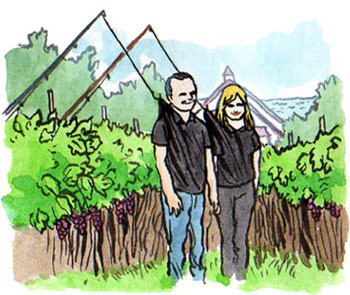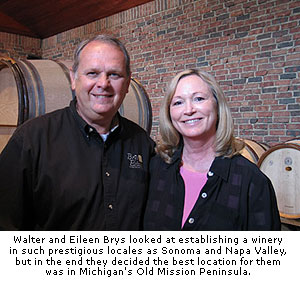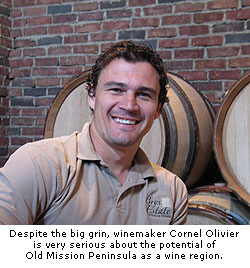

Eileen and Walter Brys, relatively big fish in the Michigan wine scene, were hooked by the qualities the region offered for a new winery.
Brys Estate: The influence of soil
"For us to jump into the sea in Michigan made a lot of business sense because we could be recognized for our commitment to what we're trying to accomplish in producing high-quality wines."
~ Walter Brys, Brys Estate proprietor
by
Eleanor & Ray Heald
October 23, 2006
Eleanor & Ray Heald (ERH): Why did you choose Michigan's Old Mission Peninsula (OMP) as the place to open your winery? In other words, what did you believe that you could do on OMP that you couldn’t do by investing elsewhere?
Walter Brys (WB): From my perspective, we were looking to do this, number one, as a business, and number two, as the fulfillment of a post retirement dream. When we considered where in the U.S. we wanted to locate, Michigan seemed right, not only as a vineyard location but a connection with family, since we’re originally from the state.
 What became apparent as we looked at sites outside Michigan was that there were a lot of big fish in the sea and we'd be just another minnow. In our opinion, Michigan and the Old Mission Peninsula AVA were coming along as a booming opportunity. For us to jump into the sea in Michigan made a lot of business sense because we could be recognized for our commitment to what we're trying to accomplish in producing high-quality wines.
What became apparent as we looked at sites outside Michigan was that there were a lot of big fish in the sea and we'd be just another minnow. In our opinion, Michigan and the Old Mission Peninsula AVA were coming along as a booming opportunity. For us to jump into the sea in Michigan made a lot of business sense because we could be recognized for our commitment to what we're trying to accomplish in producing high-quality wines.
In Michigan, we're trying to accomplish a class act with the correct combination of people.
Eileen Brys (EB): Many times, women go on feelings and, as Walt said, the other areas that we considered just didn’t feel right to me. After about two years of being discouraged by not finding the proper place, we came to OMP last and discovered it was the best. It felt totally right.
ERH: Who or what were your influences in the decision to plan an estate winery on OMP?
EB: We consulted with Jim Thompson [owner of Mutual Farm Management and former vineyard manager for Chateau Grand Traverse on OMP] about the site's potential to be a top vineyard.
ERH: Did he advise you on what varieties to plant?
WB: He had some influence. We also received input from other area winemakers, especially those in Parallel 45 Wine & Vines [an incorporated trade organization to promote the vineyard and winery industry located in Michigan's Grand Traverse Bay Area and Northwestern Lower Peninsula].
ERH: How do you believe that your property is different from other parcels in the OMP AVA?
EB: When we talked to Jim Thompson initially, he said that the property that is now Brys Estate was always a good and prosperous cherry orchard. Even when other area orchards had weather problems, this one always had very good fruit.
ERH: Do you know if there was a history of frost issues at this site?
EB: He [Thompson] said that sometimes when other orchards were having frost issues, this property had many areas that were not impacted. For instance, the severe 2003 frost did not affect our vineyards.
ERH: Cornel, you work with these vineyards and have contact with other viticulturists and winemakers on OMP, how do you believe that the Brys property is different?
Cornel Olivier (CO): Soils are heavier. Throughout the vineyard, we had 18 soil pits dug to a depth of 12 to 14 feet. No sand was found between ground level and a depth of 10 feet. Around 11 feet deep, we finally reached beach sand. The soil composition was a heavy, dark mixture of clay, loam and gravel. Darker soils offer red grapes their fruit intensity.
ERH: What varieties did you plant? Why? What clones or clonal selections?
WB: Our early concepts developed from talking to different people in the industry. Their initial advice was that white grapes offered us lower risks. Over the years, we tasted OMP reds but were not really impressed with any of them. Thus, when we planted the first part of our vineyard, we focused on Riesling, Pinot Gris, Gewürtztraminer, Pinot Blanc and less on Chardonnay. Because we are red wine advocates, we wanted to make a red grape commitment, so now 30 percent of our vineyard is planted to Merlot, Pinot Noir and Cabernet Franc.
When Cornel came on board in 2003, we turned to him and said: look at what we have and tell us what you think. And we have done some adjusting since that time.
ERH: What rootstock did you choose? Did you match the chosen rootstock to soil composition or to the variety?
CO: Most of the first varieties were planted on 3309 rootstock, which I believe has too much vigor, especially on heavy soils, so, with all new plantings, I've switched to 101-14.
Pinot Noir clones are principally Dijon, 113, 114, 115, 667 and 777. Riesling clones are 198 and 239 (with smaller clusters and berries).
ERH: How has each variety prospered?
WB: Our vines have moved along a lot better than we expected. Early advice was that we would not get a small crop until at least fourth leaf, but by third leaf, in 2003, we were able to harvest a small crop of Riesling, Cabernet Franc, Merlot and Pinot Noir.
CO: In 2003, Riesling performed well. It was very crisp with lots of malic acid. We de-acidified prior to bottling. The development of this wine in the cellar is going very well.
For Pinot Noir, the clusters weighed more than I would like. I was concerned about color intensity but the fruit was healthy and the flavor was not washed out. We picked at 22.5° Brix rather then the 25° Brix I would like us to harvest at. Yet, the wine was good and we sold out of 150 cases in 10 weeks.
In 2004, we averaged 2.5 tons per acre (TPA) for Pinot Noir, 2.3 TPA for Merlot and 2.5 TPA for Cabernet Franc.
And in 2005, Because we had such a good start, I left more shoots. Later in the season, because the weather was so good, I did not need to adjust crop levels but we did pull leaves. The result, was we got higher yields, including 3.5 TPA for Pinot Noir, 3 TPA for Cabernet Franc and 2.5 TPA for the one acre of Merlot.
ERH: Terroir, or site personality, has become more important in understanding wines from appellations worldwide. How do Brys Estate wines represent the concept?
CO: Because the Brys Estate soils are so heavy, our fruit intensity is better and the red wines are not as lean a
Walter Brys (WB): From my perspective, we were looking to do this, number one, as a business, and number two, as the fulfillment of a post retirement dream. When we considered where in the U.S. we wanted to locate, Michigan seemed right, not only as a vineyard location but a connection with family, since we’re originally from the state.
 What became apparent as we looked at sites outside Michigan was that there were a lot of big fish in the sea and we'd be just another minnow. In our opinion, Michigan and the Old Mission Peninsula AVA were coming along as a booming opportunity. For us to jump into the sea in Michigan made a lot of business sense because we could be recognized for our commitment to what we're trying to accomplish in producing high-quality wines.
What became apparent as we looked at sites outside Michigan was that there were a lot of big fish in the sea and we'd be just another minnow. In our opinion, Michigan and the Old Mission Peninsula AVA were coming along as a booming opportunity. For us to jump into the sea in Michigan made a lot of business sense because we could be recognized for our commitment to what we're trying to accomplish in producing high-quality wines.In Michigan, we're trying to accomplish a class act with the correct combination of people.
Eileen Brys (EB): Many times, women go on feelings and, as Walt said, the other areas that we considered just didn’t feel right to me. After about two years of being discouraged by not finding the proper place, we came to OMP last and discovered it was the best. It felt totally right.
ERH: Who or what were your influences in the decision to plan an estate winery on OMP?
EB: We consulted with Jim Thompson [owner of Mutual Farm Management and former vineyard manager for Chateau Grand Traverse on OMP] about the site's potential to be a top vineyard.
ERH: Did he advise you on what varieties to plant?
WB: He had some influence. We also received input from other area winemakers, especially those in Parallel 45 Wine & Vines [an incorporated trade organization to promote the vineyard and winery industry located in Michigan's Grand Traverse Bay Area and Northwestern Lower Peninsula].
ERH: How do you believe that your property is different from other parcels in the OMP AVA?
EB: When we talked to Jim Thompson initially, he said that the property that is now Brys Estate was always a good and prosperous cherry orchard. Even when other area orchards had weather problems, this one always had very good fruit.
ERH: Do you know if there was a history of frost issues at this site?
EB: He [Thompson] said that sometimes when other orchards were having frost issues, this property had many areas that were not impacted. For instance, the severe 2003 frost did not affect our vineyards.
ERH: Cornel, you work with these vineyards and have contact with other viticulturists and winemakers on OMP, how do you believe that the Brys property is different?

Cornel Olivier (CO): Soils are heavier. Throughout the vineyard, we had 18 soil pits dug to a depth of 12 to 14 feet. No sand was found between ground level and a depth of 10 feet. Around 11 feet deep, we finally reached beach sand. The soil composition was a heavy, dark mixture of clay, loam and gravel. Darker soils offer red grapes their fruit intensity.
ERH: What varieties did you plant? Why? What clones or clonal selections?
WB: Our early concepts developed from talking to different people in the industry. Their initial advice was that white grapes offered us lower risks. Over the years, we tasted OMP reds but were not really impressed with any of them. Thus, when we planted the first part of our vineyard, we focused on Riesling, Pinot Gris, Gewürtztraminer, Pinot Blanc and less on Chardonnay. Because we are red wine advocates, we wanted to make a red grape commitment, so now 30 percent of our vineyard is planted to Merlot, Pinot Noir and Cabernet Franc.
When Cornel came on board in 2003, we turned to him and said: look at what we have and tell us what you think. And we have done some adjusting since that time.
ERH: What rootstock did you choose? Did you match the chosen rootstock to soil composition or to the variety?
CO: Most of the first varieties were planted on 3309 rootstock, which I believe has too much vigor, especially on heavy soils, so, with all new plantings, I've switched to 101-14.
Pinot Noir clones are principally Dijon, 113, 114, 115, 667 and 777. Riesling clones are 198 and 239 (with smaller clusters and berries).
ERH: How has each variety prospered?
WB: Our vines have moved along a lot better than we expected. Early advice was that we would not get a small crop until at least fourth leaf, but by third leaf, in 2003, we were able to harvest a small crop of Riesling, Cabernet Franc, Merlot and Pinot Noir.
CO: In 2003, Riesling performed well. It was very crisp with lots of malic acid. We de-acidified prior to bottling. The development of this wine in the cellar is going very well.
For Pinot Noir, the clusters weighed more than I would like. I was concerned about color intensity but the fruit was healthy and the flavor was not washed out. We picked at 22.5° Brix rather then the 25° Brix I would like us to harvest at. Yet, the wine was good and we sold out of 150 cases in 10 weeks.
In 2004, we averaged 2.5 tons per acre (TPA) for Pinot Noir, 2.3 TPA for Merlot and 2.5 TPA for Cabernet Franc.
And in 2005, Because we had such a good start, I left more shoots. Later in the season, because the weather was so good, I did not need to adjust crop levels but we did pull leaves. The result, was we got higher yields, including 3.5 TPA for Pinot Noir, 3 TPA for Cabernet Franc and 2.5 TPA for the one acre of Merlot.
ERH: Terroir, or site personality, has become more important in understanding wines from appellations worldwide. How do Brys Estate wines represent the concept?
CO: Because the Brys Estate soils are so heavy, our fruit intensity is better and the red wines are not as lean a















